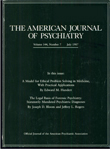This small volume is packed with significant and interesting results of a large-scale national epidemiologic survey of mental disorders in 12 regions in China. Sponsored by the Bureau of Medicine of the Ministry of Health in the People's Republic of China, with assistance from the World Health Organization, 12 centers in China were surveyed by 12 collaborating teams. Each of the centers included different geographical and sociocultural environments, and each center had a rural and urban sample of 500 households. The total sample consisted of 12,000 households comprising 51,982 individuals, 38,136 of whom were older than 15 years of age, drawn from a total sampling frame population of 2,313,470. The survey used a three-part design comprising a psychosis (key informant) survey, a children's survey, and a neurosis sampling survey. All the field work was carried out between July 1 and September or October 1982; the reference day for the point prevalence was July 1, 1982.
Two prevalence rates of mental disorders were obtained: current prevalence and total prevalence. Current prevalence rate is defined as the number of subjects per 1,000 population 15 years old or older who satisfied the criteria for the diagnosis at the time of the survey. The total prevalence rate is defined as the current prevalence rate plus the number of subjects per 1,000 population 15 years old or older who had been given the diagnosis at any time in the past.
This well-planned and well-executed survey yielded some interesting results. The overall average suicide rate was 8.5 per 100,000 total population, and the urban-rural ratio was 1.7:1. The survey revealed that a very high proportion of the families had adequate social support (86.7%) and a generally harmonious family atmosphere (97.6%). The latter is reflected in a very low formal divorce rate.
The current prevalence rate of all mental disorders was 33 per 1,000. The total prevalence rate for schizophrenia was 5.69 per 1,000 (current prevalence was 4.75 per 1,000); the total prevalence rate for mental retardation was 2.88 per 1,000. Affective psychoses had a much lower total and current prevalence (total was 0.76 per 1,000; current was 0.37 per 1,000). Among the group of psychotic disorders, there was no significant difference between the total and the current prevalence rates by sex or by urban versus rural residence. For senile dementia, the rate was 3.75 per 1,000.
The total prevalence rate for neurotic disorders was 22.2 per 1,000 individuals 15–59 years old. The current prevalence rate for neurotic disorders was 4.71 per 1,000 for men but 39.93 per 1,000 for women. In contrast to the rates for psychotic disorders, the rate for neurotic disorders was about eight times higher in women than in men. The proportionally higher rates of neurotic disorders in women could be attributed to a greater burden of responsibilities and more limited opportunities for development of personal resources of Chinese women compared with Chinese men.
These are but a few examples of the interesting findings this survey offers. Mental Disorders in China is organized for easy reference and reading. It is must reading for students of psychiatric epidemiology and anyone who is interested in the mental health aspects of one-fifth of the world's population.

